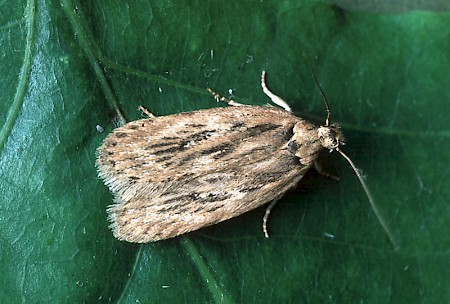32.036 BF672
Parsnip Moth Depressaria radiella
(Goeze, 1783)
[Synonyms: pastinacella]Wingspan 23-28 mm.
Generally found occupying waste ground and dry pastures, this is a fairly common species throughout the British Isles.
As the English name suggests, the larvae feed on wild parsnip (Pastinaca sativa), but also on hogweed (Heracleum).
At first the flowers and seeds are consumed, and later the larva enters the stem where it pupates.
The adults begin to hatch in September, and overwinter, appearing until the following May.
- Larva: (description Ian F. Smith):
Foodplant: June to August on flowers and young seeds of Pastinaca sativa, Heracleum sphondylium, Apium nodiflorum (in Channel Islands) and Heracleum mantegazzianum (in Netherlands, Denmark and elsewhere in Europe, Nielsen, in litt.). Often gregarious in a silk web distorting the flower panicle. Occasionally in unopened flower buds.
Length: 19 mm to 24 mm described. Parasitized larvae may be larger. (variations of other instars in brackets).
Head: Black.
Prothoracic shield: Black, divided by a narrow yellowish medial line.
Thoracic legs: Black.
Body: Dorsally pale grey. Ventrally dull yellow. (9 mm; dull amber all over.)
Spiracles: Black peritreme.
Pinacula: Large, black. (9 mm relatively smaller.)
Setae: Black. (9mm brownish translucent.)
Anal plate: Distinct. Light brown with blackish periphery. (9mm coloured as body.) (MBGBI states black, but this colour not observed in large series of larvae raised from several sources).
Prolegs: Coloured as venter. Black collar on base and on planta (absent on 9 mm
larva).
Pupa: July to early September in the main stem of the food plant. Constricted
seedhead remains and a hole, about 3 mm diameter, indicate stems
occupied by pupae and, sometimes, fossilised failed larvae which retain
vestiges of the grey and yellow colouration.
Comment: Pastinaca, Heracleum mantegazzianum and probably other foodplants contain chemicals which can cause painful blistering in the presence of sunlight. Care should be taken to avoid contact with the sap from cut stems. Larvae are often adjusted to the toxins in a particular population of a foodplant, and may not prosper if transferred to the same species of plant from another source. See http://www.life.uiuc.edu/berenbaum

 UKMoths
UKMoths 







